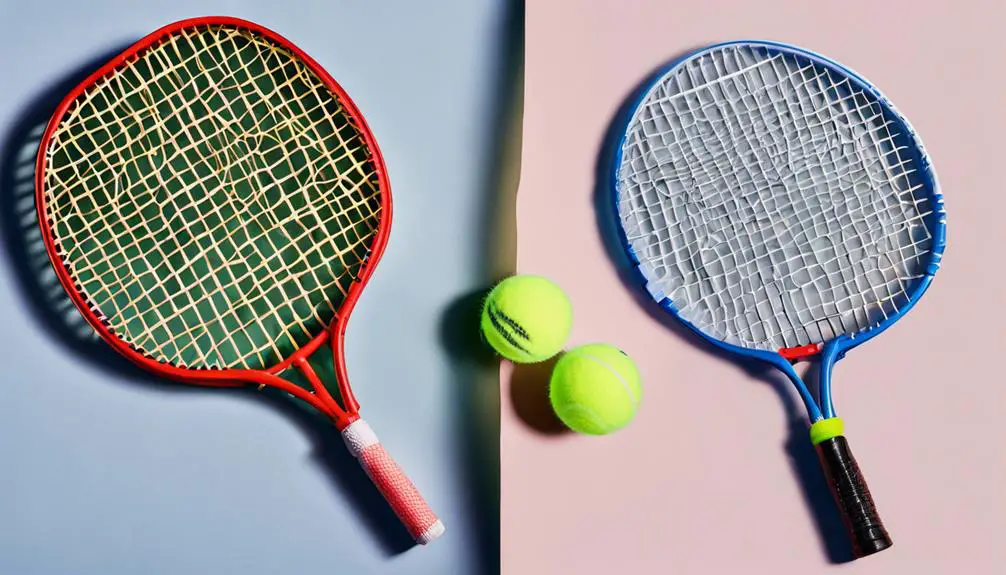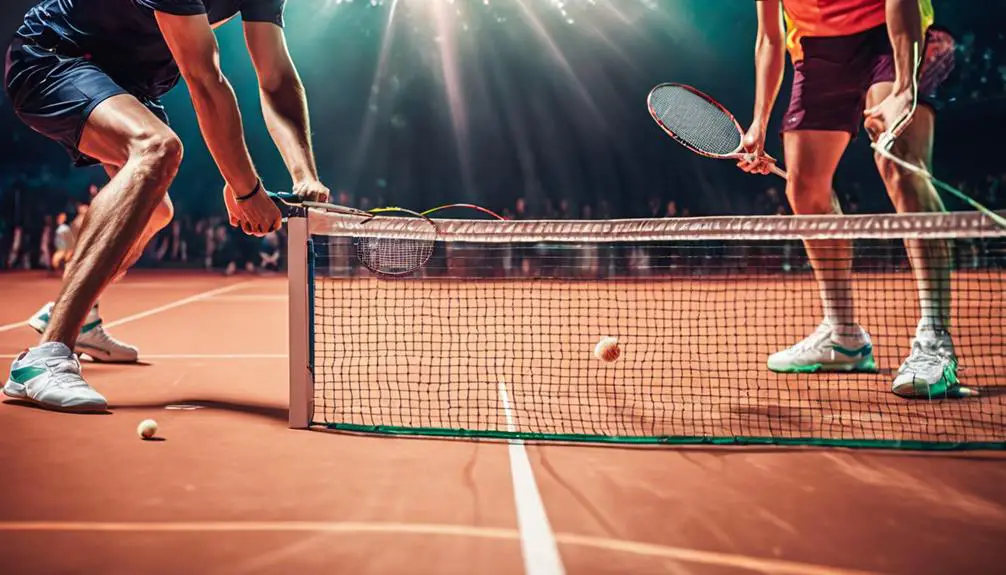When comparing badminton and tennis, you’ll find each sport offers a unique appeal. Badminton emphasizes speed, quick reflexes, and strategic shot placement on a smaller court. Its game tempo is fast, relying heavily on agility and mental acuity. In contrast, tennis features a broader playing field with varied styles, from power hitting to finesse at the net. The scoring systems differ too; badminton uses rally scoring, while tennis allows only the server to score on their serve. Both sports boast health benefits and immense global popularity. There’s much more to explore about their nuanced differences and similarities.
Overview of Badminton

Badminton, while often overshadowed by its more popular counterpart tennis, offers a unique blend of strategy, speed, and skill that fascinates players and spectators alike. To truly appreciate the game, it’s crucial to understand its rich badminton history, which traces back to ancient civilizations in Asia. The modern version, however, took shape in the mid-19th century in England, evolving from a game called battledore and shuttlecock. This historical evolution highlights how badminton has adapted and grown, reflecting cultural shifts and innovations in sports.
When you step onto the court, you’ll quickly discover that badminton techniques are as varied as they are essential. Mastering the fundamentals—like grip, footwork, and shuttlecock control—sets the foundation for advanced tactics. You’ll find that the game’s strategic elements demand quick thinking and adaptability, whether you’re executing a drop shot or a powerful smash.
Moreover, the importance of positioning cannot be overstated. You’ll need to anticipate your opponent’s moves and adjust your own to maintain control of the rally. The blend of agility and mental acuity in badminton creates a dynamic experience that keeps players engaged and challenged.
Ultimately, badminton isn’t just about physical prowess; it’s about the thrill of outsmarting your opponent and the freedom of self-expression through your playing style. So grab your racket and immerse yourself in this exhilarating sport, where the history and the techniques come together to create something truly fascinating.
Overview of Tennis
While many might think of tennis as merely a game of power and precision, it encompasses a rich tapestry of history, strategy, and athleticism that captivates players and fans worldwide. Originating in the late 12th century in France, tennis evolved from a handball game to its modern form, showcasing its ability to adapt and thrive through the ages. The sport’s history is dotted with significant milestones, from the establishment of Wimbledon in 1877 to the Open Era in 1968, which democratized professional play.
In terms of strategy, tennis demands more than just physical prowess. You need to understand your opponent’s weaknesses, anticipate their shots, and create opportunities for yourself. This strategic depth is part of what makes matches so thrilling to watch. It’s not just about the serve; it’s about the mental chess game that unfolds on the court.
The sport has also produced a slew of famous players, each leaving their mark on tennis history. Icons like Serena Williams, Roger Federer, and Rafael Nadal have not only dominated the game but have inspired countless individuals to pick up a racket. Their rivalries and achievements have shaped the sport, making it more than just competition—it’s a narrative of resilience and excellence.
In essence, tennis is a celebration of skill, strategy, and history. Whether you’re playing casually or watching a Grand Slam, you’re part of a legacy that transcends generations, inviting you to engage with its thrilling complexities.
Equipment Comparison

When comparing badminton and tennis, one of the most striking differences lies in the equipment used in each sport. In badminton, you’ll find rackets that are lightweight and designed for quick movements, often made of materials like carbon fiber or aluminum. Conversely, tennis rackets are sturdier, with varying racket types tailored to different playing styles, often constructed from advanced composites for power and control.
Shuttlecock materials vary greatly, with feather shuttlecocks offering speed and precision, while nylon ones provide durability for recreational play. In tennis, the ball is made from rubber and felt, designed for bounce and spin, essential for gameplay.
String tension is another key factor. Badminton rackets typically feature higher tension for enhanced control, while tennis rackets have a broader range to accommodate power and spin preferences. Grip sizes also differ; badminton players tend to opt for thinner grips for quick wrist action, while tennis players may choose thicker grips for better stability during powerful swings.
Footwear choices are vital in both sports. Badminton shoes are lightweight with non-marking soles for quick lateral movements, while tennis shoes are more robust to withstand the wear of hard courts. Additionally, net height is another distinction, with badminton nets being considerably lower than those in tennis, affecting gameplay dynamics.
Court Dimensions
In comparing court dimensions, you’ll notice considerable differences that influence the gameplay of badminton and tennis. The courts for each sport are designed with unique measurements and layouts, which ultimately shape how the game is played. Badminton courts are smaller, measuring 13.4 meters long and 6.1 meters wide for doubles play, while tennis courts stretch to 23.77 meters in length and 8.23 meters wide for doubles matches. This difference in size means that badminton players rely on quick reflexes and agility within a compact space, whereas tennis players can utilize the larger area for more strategic positioning and powerful shots.
Another key aspect is the court surfaces. Badminton is typically played on wooden or synthetic surfaces that provide a good grip and allow for quick movements, while tennis courts can be made of grass, clay, or hard materials like asphalt or concrete. Each surface affects ball behavior and player movement, adding layers of strategy to both games.
Boundary markings also differ considerably. In badminton, the lines are narrower and designed for quick, precise shots, with distinct areas for singles and doubles. Tennis, on the other hand, features broader lines that define service boxes and baselines, catering to a variety of playing styles and strategies.
Understanding these court dimensions and their implications can enhance your appreciation of both sports, highlighting how even subtle differences can lead to vastly different experiences on the court.
Scoring Systems

Scoring systems in badminton and tennis reveal fundamental differences that affect how matches unfold. Understanding these differences can enhance your appreciation for each sport’s unique dynamics. Here are three key points to reflect on:
- Rally Scoring: In badminton, every rally counts regardless of who serves, meaning you can score points at any moment. Tennis, on the other hand, uses a point system where only the server can score on their serve, adding a layer of strategy to serving order.
- Match Formats: Badminton typically employs a best-of-three games format, with each game played to 21 points, while tennis matches can vary widely, featuring best-of-three or best-of-five sets. This affects game duration and pacing, often leading to longer tennis matches.
- Tiebreak Rules: In badminton, if the score reaches 20-20, a player must win by two points. Tennis often uses a tiebreak at 6-6 in sets, where the first player to reach seven points with a two-point lead wins. These variations influence player strategy and can shift the momentum dramatically.
Both sports require adaptability, but the scoring systems dictate how players approach each match. In badminton, the continuous potential for scoring can lead to aggressive, fast-paced gameplay, while tennis often involves more strategic play, especially during significant tiebreak situations. Understanding these differences can deepen your insight into how athletes navigate their respective courts.
Playing Styles
Playing styles in badminton and tennis showcase distinct approaches that reflect the athletes’ strengths and strategies. In badminton, you often see quick, agile movements with a focus on offensive strategies, where players utilize rapid shot variations to keep opponents off balance. The shuttlecock’s speed demands precise player positioning, allowing you to capitalize on openings in your opponent’s defense. The game tempo is frenetic, and rallies can change direction in an instant, requiring exceptional match endurance.
Conversely, tennis emphasizes a blend of power and finesse. Players employ diverse serve techniques to dictate the early phase of points, setting the tone for the rally dynamics to follow. You might find yourself adopting defensive techniques, especially against powerful opponents, where positioning and strategic shot selection are vital. Here, the court’s dimensions allow for a more deliberate pacing, with players crafting longer rallies that test stamina and mental resilience.
Both sports require adaptability; in badminton, you’ll react swiftly to fast-paced exchanges, while in tennis, you might engage in strategic forehand and backhand battles. The contrast in styles not only influences how you approach each game but also shapes your overall athletic development. Ultimately, whether you’re smashing a shuttle or serving an ace, understanding these playing styles enhances your appreciation for the sport and sharpens your competitive edge.
Health Benefits

Embracing the dynamic nature of badminton and tennis offers a wealth of health benefits that extend beyond mere physical fitness. Not only do both sports keep you active, but they also contribute greatly to your overall well-being. Here are three key benefits you can enjoy:
- Cardiovascular Health: Engaging in either sport elevates your heart rate, strengthening your heart and improving circulation. This can lead to lower blood pressure and reduced risk of heart disease.
- Muscle Strength: As you play, you’ll develop muscle strength throughout your body, particularly in your legs, core, and arms. This increased strength not only enhances your performance but also supports daily activities.
- Mental Agility: Both badminton and tennis require quick thinking and strategic planning, which promotes mental agility. Staying sharp mentally is vital for maintaining cognitive health as you age.
In addition to these benefits, playing badminton or tennis fosters social interaction. Whether you’re hitting the court with friends or joining a local league, these activities create opportunities for camaraderie and support. Plus, the intense nature of these sports aids in weight management, helping you burn calories effectively.
Lastly, regular participation can enhance injury prevention, as both sports improve coordination and flexibility. By incorporating badminton or tennis into your routine, you’re not just having fun; you’re investing in a healthier, more active lifestyle. So grab your racket and embrace the myriad benefits these sports can provide!
Global Popularity
Both badminton and tennis not only offer significant health benefits but also boast remarkable global popularity, making them two of the most widely played sports in the world. When you consider the cultural significance of these sports, it’s clear they resonate deeply across various societies. Tennis, for instance, has an illustrious history intertwined with royalty and elite circles, drawing large audiences to Grand Slam tournaments. The Wimbledon Championships, with its traditions and pageantry, exemplify this cultural appeal, drawing fans from all walks of life.
On the other hand, badminton has gained traction, especially in Asia, where it’s not just a sport but a way of life. Countries like Indonesia, China, and Malaysia celebrate badminton with fervor that showcases the sport’s cultural importance. The Badminton World Federation’s efforts to promote the sport globally have led to increased fan engagement, making it a staple in schools and communities.
You’ll find that both sports encourage participation at grassroots levels, nurturing a sense of community and shared passion. Local clubs and organizations foster an environment where budding athletes can thrive, while professional leagues capture the imagination of fans worldwide.
Frequently Asked Questions
What Are the Major International Tournaments for Badminton and Tennis?
When exploring major international tournaments, you’ll find badminton championships like the World Championships and Sudirman Cup, alongside tennis’s Grand Slam tournaments—Australian Open, French Open, Wimbledon, and US Open—showcasing the pinnacle of competition in each sport.
How Do Weather Conditions Affect Badminton and Tennis Games?
Weather conditions greatly impact gameplay; humidity effects can alter players’ performance, while court surfaces react differently to moisture. Understanding these factors helps you strategize effectively, ensuring you’re always prepared for any environmental challenges.
What Are the Common Injuries in Badminton and Tennis?
In the dance of sport, you’ll encounter common injuries like ankle sprains, shoulder injuries, wrist strains, and knee pain. Understanding these risks can help you navigate the game with freedom and agility, minimizing setbacks.
Are There Different Playing Techniques for Singles and Doubles?
Yes, there’re different techniques for singles and doubles. In singles, focus on court positioning and personal serving strategies, while doubles emphasizes teamwork and strategic placement, ensuring you and your partner cover the court effectively.
How Do Training Regimens Differ Between Badminton and Tennis Players?
Ever wondered why athletes train differently? Your regimen focuses on endurance training and strength conditioning, with badminton emphasizing quick reflexes and agility, while tennis prioritizes stamina and power for those longer rallies and intense matches.




